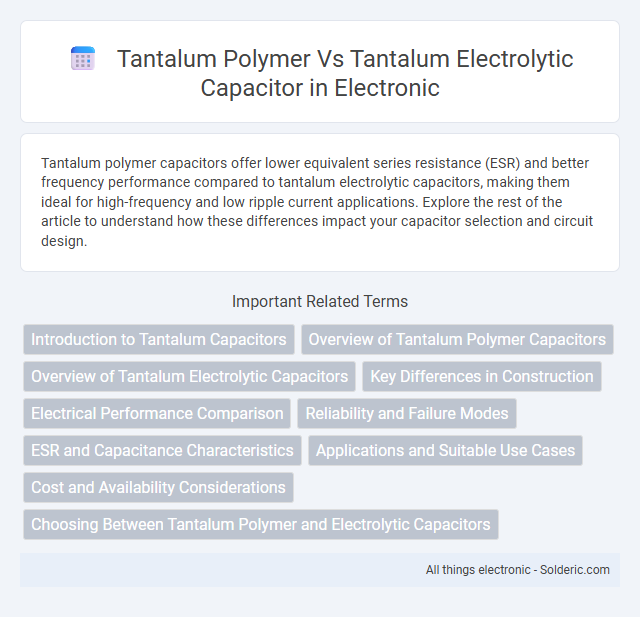Tantalum polymer capacitors offer lower equivalent series resistance (ESR) and better frequency performance compared to tantalum electrolytic capacitors, making them ideal for high-frequency and low ripple current applications. Explore the rest of the article to understand how these differences impact your capacitor selection and circuit design.
Comparison Table
| Feature | Tantalum Polymer Capacitor | Tantalum Electrolytic Capacitor |
|---|---|---|
| Dielectric | Tantalum oxide with conductive polymer | Tantalum oxide with manganese dioxide electrolyte |
| Equivalent Series Resistance (ESR) | Low ESR (5-15 mO) | Higher ESR (30-100 mO) |
| Reliability | High reliability, fails short | Moderate reliability, can fail open or short |
| Frequency Response | Excellent high-frequency performance | Moderate frequency performance |
| Voltage Range | Up to 63 V | Up to 50 V commonly |
| Capacitance Range | 0.1 uF to several hundred uF | 1 uF to several thousand uF |
| Temperature Range | -55degC to +125degC | -55degC to +85degC (some up to 125degC) |
| Size | Compact, low profile | Larger, bulkier |
| Cost | Higher cost | Lower cost |
Introduction to Tantalum Capacitors
Tantalum capacitors utilize tantalum metal as the anode, offering high capacitance per volume and stable electrical performance. Tantalum polymer capacitors feature a conductive polymer cathode, providing lower equivalent series resistance (ESR), enhanced reliability, and better frequency response compared to traditional tantalum electrolytic capacitors, which use manganese dioxide cathodes. These differences make tantalum polymer capacitors more suitable for high-performance applications requiring durability and efficiency, such as power management circuits in portable electronics.
Overview of Tantalum Polymer Capacitors
Tantalum polymer capacitors feature a conductive polymer as the cathode, providing lower Equivalent Series Resistance (ESR) and improved high-frequency performance compared to traditional tantalum electrolytic capacitors. They offer enhanced reliability, better stability under high surge currents, and a longer lifespan, making them suitable for advanced consumer electronics and automotive applications. These capacitors also exhibit higher capacitance per volume and better tolerance to temperature variations, optimizing power efficiency in compact circuit designs.
Overview of Tantalum Electrolytic Capacitors
Tantalum electrolytic capacitors utilize a tantalum metal anode combined with a solid or liquid electrolyte to achieve high capacitance in a compact size. These capacitors offer stable electrical characteristics, including low equivalent series resistance (ESR) and high volumetric efficiency, making them suitable for space-constrained applications. They differ from tantalum polymer capacitors primarily in electrolyte type, with tantalum electrolytics typically exhibiting higher capacitance but lower ripple current tolerance and reliability under stress.
Key Differences in Construction
Tantalum polymer capacitors utilize a conductive polymer as the cathode, significantly reducing equivalent series resistance (ESR) and enhancing frequency response compared to tantalum electrolytic capacitors, which rely on a manganese dioxide or electrolytic cathode. The solid conductive polymer in tantalum polymer capacitors offers improved reliability and stability over liquid or solid electrolytes found in electrolytic types. Construction differences result in distinct performance characteristics, with tantalum polymer capacitors providing superior performance in high-frequency and low-ESR applications.
Electrical Performance Comparison
Tantalum polymer capacitors offer lower Equivalent Series Resistance (ESR) and higher ripple current capabilities compared to traditional tantalum electrolytic capacitors, resulting in improved efficiency and thermal stability. Their enhanced electrical performance supports faster transient response and better frequency characteristics, making them ideal for high-performance applications. You benefit from longer lifespan and reduced voltage derating requirements with tantalum polymer technology over electrolyte-based counterparts.
Reliability and Failure Modes
Tantalum polymer capacitors exhibit higher reliability due to their solid polymer electrolyte, which significantly reduces the risk of catastrophic failures such as ignition or explosion compared to tantalum electrolytic capacitors that use liquid electrolytes prone to leakage and drying out. The failure modes of tantalum polymer capacitors primarily involve gradual degradation characterized by increased equivalent series resistance (ESR) and capacitance loss, whereas tantalum electrolytic capacitors often fail abruptly due to dielectric breakdown and short circuits under voltage surges. Polymer tantalum capacitors also demonstrate improved tolerance to ripple current and temperature variations, enhancing their long-term stability in high-stress electronic applications.
ESR and Capacitance Characteristics
Tantalum polymer capacitors exhibit significantly lower Equivalent Series Resistance (ESR), often in the milliohm range, resulting in improved performance for high-frequency applications and better thermal stability compared to tantalum electrolytic capacitors. While tantalum electrolytic capacitors offer higher capacitance values per volume due to their liquid electrolyte, they typically have higher ESR and limited frequency response. The polymer variant combines stable capacitance characteristics with enhanced ripple current handling and longer lifespan, making it ideal for modern power management circuits.
Applications and Suitable Use Cases
Tantalum polymer capacitors excel in high-frequency and low-ESR applications such as smartphone motherboards, automotive electronics, and aerospace systems, offering superior stability and reliability under demanding conditions. Tantalum electrolytic capacitors are more suited for cost-sensitive, bulk energy storage and DC filtering in power supply circuits and industrial equipment where moderate ESR and higher ripple currents are acceptable. You should choose tantalum polymer capacitors when compact size and high performance in ripple current handling are critical, while traditional tantalum electrolytic capacitors provide a budget-friendly solution for general-purpose filtering and energy storage needs.
Cost and Availability Considerations
Tantalum polymer capacitors generally have higher upfront costs compared to tantalum electrolytic capacitors due to advanced materials and manufacturing processes. Availability of tantalum polymer capacitors can be more limited, especially in bulk quantities, whereas tantalum electrolytic capacitors are widely produced and more readily accessible on the market. You should weigh the cost premium against performance benefits when deciding which type suits your application and budget constraints.
Choosing Between Tantalum Polymer and Electrolytic Capacitors
Choosing between tantalum polymer and tantalum electrolytic capacitors depends on your application's requirements for performance and reliability. Tantalum polymer capacitors offer lower equivalent series resistance (ESR) and higher capacitance stability under load, making them ideal for high-frequency and temperature-sensitive circuits. Your decision should consider factors like cost, voltage rating, and ripple current tolerance, where tantalum electrolytic capacitors may be preferred for budget-sensitive, high-capacitance needs.
tantalum polymer vs tantalum electrolytic capacitor Infographic

 solderic.com
solderic.com